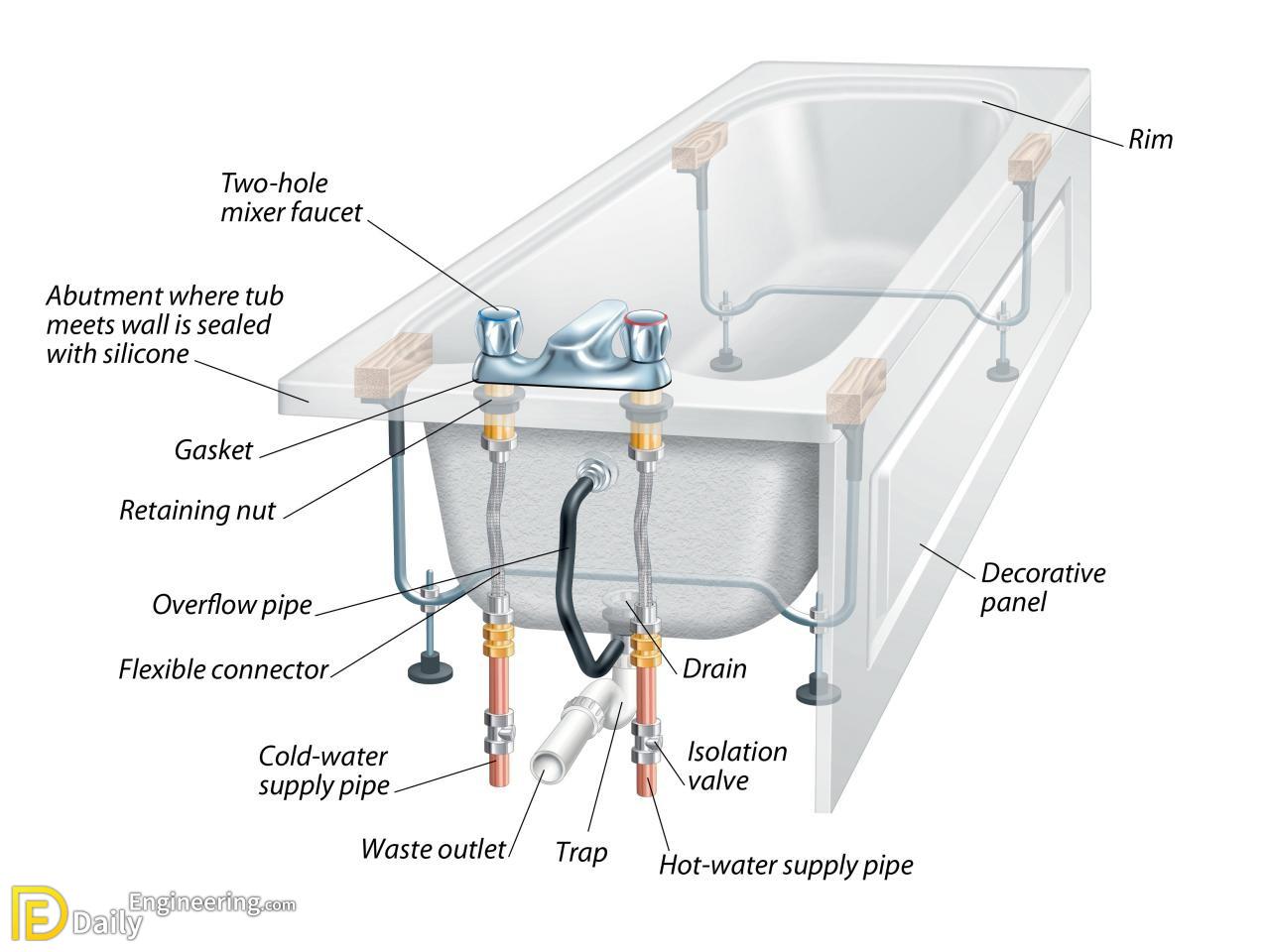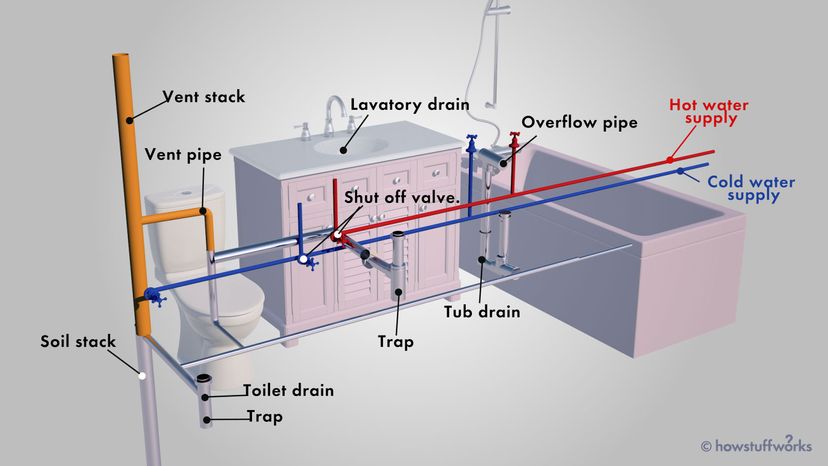Basic Bathroom Plumbing Components and Their Functions: Bathroom Plumbing Diagram With Shower

A basic bathroom plumbing system consists of several essential components that work together to deliver water to fixtures and remove wastewater. Understanding the function of each component is crucial for maintaining a functional and efficient bathroom.
Water Supply Lines
Water supply lines are responsible for delivering water to bathroom fixtures such as sinks, toilets, showers, and bathtubs. These lines typically consist of copper, PVC, or PEX piping, each with its own advantages and disadvantages.
- Copper pipes are known for their durability and resistance to corrosion, but they can be expensive and susceptible to damage from freezing temperatures.
- PVC pipes are more affordable than copper and resistant to corrosion, but they are less durable and can be prone to leaks.
- PEX pipes are flexible and easy to install, making them a popular choice for new construction. They are also resistant to corrosion and freezing temperatures.
Drain Lines
Drain lines are responsible for carrying wastewater away from bathroom fixtures. These lines are typically made of PVC or ABS plastic and are connected to a main drain line that leads to the sewer system. Drain lines are designed to slope downward to ensure that wastewater flows smoothly and does not back up.
Vent Lines
Vent lines are crucial for preventing sewer gases from entering the bathroom. They connect to the drain lines and extend up through the roof, allowing air to enter the drain system and prevent pressure buildup. This prevents the gurgling sounds often associated with a blocked drain.
Hot and Cold Water Lines, Bathroom plumbing diagram with shower
Hot and cold water lines are distinct pipes that deliver hot and cold water to bathroom fixtures. Hot water lines are typically marked with a red band or stripe, while cold water lines are marked with a blue band or stripe.
Bathroom Plumbing Components
| Component | Function | Material | Location |
|---|---|---|---|
| Water Supply Line | Delivers water to fixtures | Copper, PVC, PEX | From water main to fixtures |
| Drain Line | Carries wastewater away | PVC, ABS | From fixtures to main drain |
| Vent Line | Prevents sewer gas buildup | PVC, ABS | Connects to drain line and extends to roof |
| Shower Head | Disperses water for showering | Plastic, metal | Attached to shower arm |
| Shower Arm | Connects shower head to plumbing | Metal | Extends from wall |
| Shower Valve | Controls water flow and temperature | Metal | Mounted on wall |
| Tub Spout | Disperses water for bathing | Metal | Attached to bathtub |
| Tub Drain | Allows water to drain from bathtub | Metal, plastic | Located at bottom of bathtub |
| Sink Faucet | Controls water flow and temperature | Metal | Mounted on sink |
| Sink Drain | Allows water to drain from sink | Metal, plastic | Located at bottom of sink |
| Toilet Tank | Stores water for flushing | Ceramic, plastic | Located on top of toilet bowl |
| Toilet Bowl | Collects wastewater | Ceramic | Located below toilet tank |
| Toilet Flush Valve | Releases water from tank to bowl | Plastic, metal | Located inside toilet tank |
Shower Plumbing Diagram

Understanding the plumbing system behind your shower is crucial for both troubleshooting issues and making informed decisions during renovations or upgrades. This diagram will illustrate the key components and their connections, providing a visual guide to the flow of water through your shower system.
Shower System Components and Connections
A typical shower system consists of several essential components that work together to deliver water to the shower head. The components include:
- Shower Head: The shower head is the final outlet where water is dispersed for showering. It connects to the shower arm, which is usually attached to the wall. Modern shower heads offer various spray patterns and water-saving features.
- Shower Valve: The shower valve controls the flow of water to the shower head. It typically includes a handle for adjusting the water temperature and a diverter for switching between shower and tub outlets. The valve is usually mounted behind the wall, with trim plates visible on the front.
- Diverter: The diverter is a component of the shower valve that directs the water flow to either the shower head or the tub spout. It often has a lever or button to switch between the two outlets.
- Pipe Connections: The shower system is connected to the main water supply lines through a series of pipes. These pipes carry hot and cold water to the shower valve and then to the shower head. The pipes can be made of various materials, such as copper, PEX, or CPVC.
Shower System Connections
The shower system is connected to the main water supply and drain lines at specific points:
- Water Supply: The hot and cold water supply lines connect to the shower valve. These lines typically originate from the main water supply pipes, which run throughout the house.
- Drain: The shower drain connects to the main drain line, which carries wastewater away from the bathroom. The drain is typically located in the shower floor, and it connects to the drain pipe through a trap.
Water Flow Through the Shower System
Here’s a step-by-step guide to understand how water flows through a typical shower system:
- Water Supply: Hot and cold water enters the shower system from the main water supply lines.
- Shower Valve: The water flows into the shower valve, where it is mixed to achieve the desired temperature.
- Diverter: The diverter directs the water flow to either the shower head or the tub spout, depending on the user’s preference.
- Shower Head: The water flows through the shower head, where it is dispersed in a spray pattern.
- Drain: After showering, the water drains through the shower drain and into the main drain line.
Shower System Connection Types
Here’s a table illustrating common connection types used in a shower system:
| Element | Connection Type |
|---|---|
| Shower Head to Shower Arm | Threaded Connection |
| Shower Arm to Wall | Threaded Connection |
| Shower Valve to Supply Lines | Threaded Connection |
| Shower Valve to Diverter | Threaded Connection |
| Diverter to Shower Head or Tub Spout | Threaded Connection |
| Shower Drain to Drain Pipe | Threaded Connection |
Common Bathroom Plumbing Issues and Troubleshooting Tips
A well-functioning bathroom is essential for a comfortable and hygienic living environment. However, plumbing issues can arise, often impacting shower functionality. Understanding common problems and troubleshooting techniques can help you address these issues effectively and prevent future complications.
Shower Leaks
Leaks in showers can be frustrating and costly, leading to water damage and increased water bills. Identifying the source of the leak is crucial for effective repair.
- Showerhead Leaks: Worn-out O-rings or washers in the showerhead can cause leaks. Replacing these parts usually resolves the issue.
- Faucet Leaks: Leaky faucets can stem from worn-out cartridges, O-rings, or washers. Replacing these components can often stop the leak.
- Pipe Leaks: Leaks in the pipes supplying the shower can be more complex. Identifying the specific pipe location and using appropriate repair techniques are essential.
Low Water Pressure in Shower
Low water pressure in the shower can be an inconvenience, making it difficult to enjoy a satisfying shower experience. Several factors can contribute to this issue.
- Clogged Showerhead: Mineral deposits or debris can clog the showerhead, restricting water flow. Cleaning the showerhead can restore water pressure.
- Partially Closed Valve: A partially closed valve supplying the shower can reduce water pressure. Opening the valve fully can resolve the issue.
- Restricted Pipes: Mineral buildup or corrosion in the pipes can restrict water flow. Cleaning or replacing the pipes may be necessary.
Shower Drainage Issues
Slow or clogged shower drains can create a messy and unsanitary bathroom environment. Identifying the cause of drainage issues is essential for effective troubleshooting.
- Hair and Debris Accumulation: Hair, soap scum, and other debris can accumulate in the drain, obstructing water flow. Regularly cleaning the drain can prevent clogs.
- Pipe Blockage: Blockages in the drainpipe can restrict water flow. Using a plunger or drain snake to remove the blockage can restore drainage.
- Tree Roots: In some cases, tree roots can penetrate drainpipes, causing blockages. Professional assistance may be required to address this issue.
Preventing Future Plumbing Problems
Regular maintenance and preventive measures can help minimize the likelihood of bathroom plumbing issues.
- Regular Cleaning: Clean showerheads, faucets, and drains regularly to prevent clogs and mineral buildup.
- Water Pressure Regulation: Maintain proper water pressure by checking and adjusting the pressure regulator as needed.
- Pipe Inspection: Regularly inspect pipes for signs of leaks, corrosion, or damage. Address any issues promptly.
- Professional Maintenance: Consider scheduling professional plumbing inspections and maintenance to identify and address potential issues before they become major problems.
Common Bathroom Plumbing Issues and Solutions
| Issue | Cause | Solution |
|---|---|---|
| Leaky Faucet | Worn-out O-rings or washers | Replace the O-rings or washers. |
| Low Water Pressure | Clogged showerhead | Clean the showerhead. |
| Slow Drain | Hair and debris accumulation | Clean the drain regularly. |
A bathroom plumbing diagram with shower typically includes the water supply lines, drain lines, and the shower head itself. While tackling a plumbing project, you might also want to keep track of your progress, and for that, you’ll need a reliable scale.
Check out this guide to best accurate bathroom scales 2015 for a good selection. Once you’ve finished your plumbing work, you can step on the scale to celebrate your accomplishment! Back to the plumbing diagram, make sure to consider the placement of the shower head in relation to the drain for optimal water flow and drainage.
A bathroom plumbing diagram with shower often highlights the drain, which can be a source of trouble. If you’re facing a clogged drain, a best bathroom drain unblocker can be a lifesaver. Understanding the plumbing diagram helps you identify the best location for the unblocker, ensuring a smooth flow of water through your shower drain.
